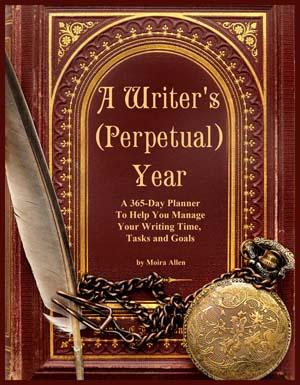 Your Guide to a Successful Writing Career
| ||||
|
by Moira Allen
Q: I am confused by the term "simultaneous submissions." Does "simultaneous submissions" mean that if a publisher accepts them, the story can also be published in two or more publications? Or, if one publication accepts, should the story be withdrawn from other publishers? -- John S., Singapore "Simultaneous submission" is generally understood as the practice of sending your work to several different publications at the same time -- but with the understanding that only one of those publications will actually acquire the right to use it. When you send out simultaneous submissions, you are usually offering exclusive rights to the publication that chooses to accept it. If more than one publication wants to use the piece, you will have to choose between those markets, and withdraw the piece from the others. When you offer "simultaneous submissions" to several different magazines, you're effectively turning your submission into an auction, asking "Which one of you wants this?" or even "Which of you will give me the best deal?" Unfortunately, that is a situation that most editors absolutely hate.
Writers and editors have been haggling over this issue for decades. From a writer's perspective, simultaneous submissions offer a distinct advantage: They offer a way to "beat" a system that has never been writer-friendly in the first place. The traditional way to submit material is "sequential." You send your work to Publication A, and wait 6 to 8 weeks (or more) for a response. If you receive a rejection, you send the material on to Publication B, and wait again. If you receive another rejection, you try Publication C, and then Publication D, and so on. Obviously, this process is very time-consuming: It could take months for you to find a buyer for your work. But what if Publications A, B, C, D, and so on could all look at your work at the same time? Then you'd have to wait only 6 to 8 weeks total to find a buyer! That sounds logical, and I always have a terrible time convincing writing students not to do it. The "traditional" way leaves a lot to be desired -- but trying to beat the system has consequences. The most significant of these is "angry editors." Editors hate simultaneous submissions. While a few accept them, the vast majority still do not. Nor are they simply being arbitrary grouches, chuckling over the pain they inflict on hapless writers: Editors have their reasons for disliking this system. The reason is simple: Most editors make their buying decisions based on how a particular piece will fit into the context of a specific issue. Once an editor has made plans for an article or story, the last thing s/he wants to hear is that the piece is no longer available -- because it has been sold to someone else. Editors become particularly irritated if this happens when the issue is about to close, and they must now scramble to fill the "hole" left by the withdrawn piece. But what about publications that do accept simultaneous submissions? Should you take advantage of that opportunity and submit to several publications at once (assuming each has the same policy)? You can -- but you should be aware that this procedure has its risks. One risk is the chance of offending an editor. If more than one publication offers to accept your material, you must choose between them -- which means withdrawing your story from a market that has expressed an interest in your work. If you withdraw your material, you risk alienating an editor who might otherwise have been a good market for your next story, and your next. That editor may regard your future submissions with suspicion: How does s/he know that you won't withdraw again? A second risk is jumping too soon, and accepting the wrong offer. What if one publication offers you a contract and you accept -- only to be offered a much better contract by another publication a couple of weeks later? The sad fact is that you're stuck with the first contract you sign, no matter how good a subsequent offer may be. (If you really want to alienate editors, try breaking a contract after you've accepted an offer!) This is where "sequential submissions" have an advantage: If you start at the "top" of your market list, with the markets that offer the best rates and terms, and work your way downward, you'll never have to worry about waiting for a "better" offer. (Never start at the bottom of your list and work up!) The bottom line is that simultaneous submissions involve risk -- to the writer and to the editor. That doesn't mean that you should never choose this route, but it should be chosen with caution. A better option, I believe, is to write more stories or articles instead, so that you have enough original material in the pipeline to keep your work in front of several different editors at the same time -- and if they all say "yes," you won't have to disappoint any of them.
Many readers have commented that the sequential approach breaks down in today's market when more and more editors no longer bother to respond to submissions with a rejection. When editors don't actively "reject" (but simply "reject" by failing to respond), this leaves writers dangling. Shouldn't writers have the option of combatting this problem by resorting to simultaneous submissions? My response to this concern is that, first, it's absolutely valid. Today, actual rejections (as opposed to non-responses) seem to be the exception rather than the norm. I don't believe that simultaneous submissions per se are the best answer, however. A simultaneous submission is, by definition, the act of sending the same query or article to different markets at the same time. I still recommend using a sequential approach; however, I also recommend that writers no longer rely upon editors to set the pace of their submissions. Most publications do post a "response time," even if it's simply "if you have not heard from us in X weeks, assume rejection." If they do not, a response time of six weeks is generally considered reasonable. Therefore, when sending your query or submission, include a statement that if you have not heard from the editor either within their posted response time (if there is one) or within six weeks (if there isn't), you will assume that the material is no longer being considered for publication and you will submit it elsewhere. This removes the need to wait indefinitely for a response, while avoiding the issue of actually submitting simultaneously.
Moira Allen is the editor of Writing-World.com, and has written nearly 400 articles, serving as a columnist and regular contributor for such publications as The Writer, Entrepreneur, Writer's Digest, and Byline. An award-winning writer, Allen is the author of numerous books, including Starting Your Career as a Freelance Writer, The Writer's Guide to Queries, Pitches and Proposals, and Coping with Sorrow on the Loss of Your Pet. In addition to Writing-World.com, Allen hosts VictorianVoices.net, a growing archive of articles from Victorian periodicals, and The Pet Loss Support Page, a resource for grieving pet owners. She lives in Kentucky with her husband and the obligatory writer's cat. She can be contacted at editors "at" writing-world.com. |
| |||
| ||||




